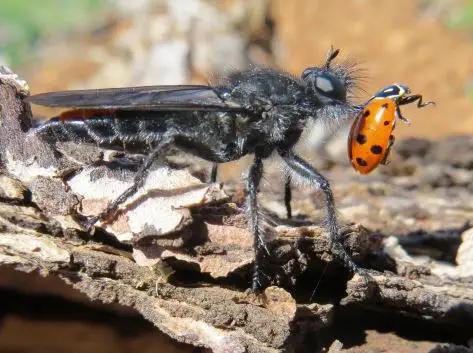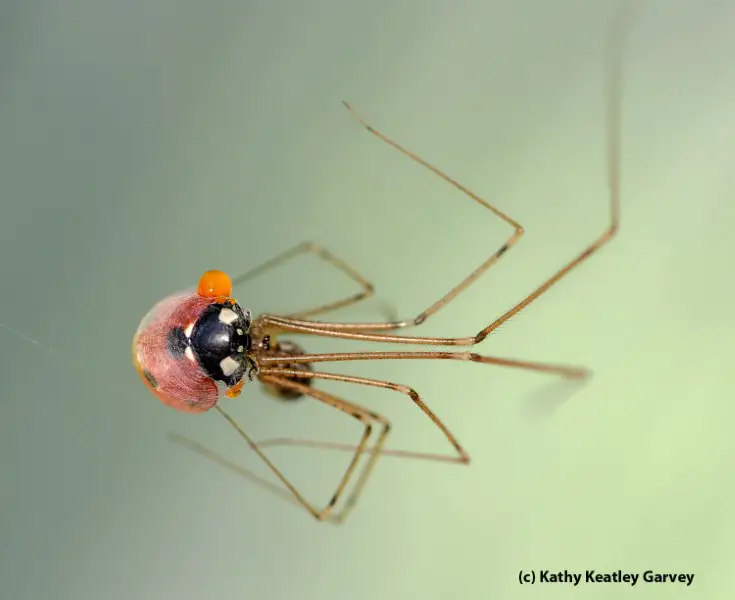It actually surprised me to learn that anything eats ladybugs at all! Partly as I assumed everything on the planet would look at them and like I would think ‘aww aren’t they cute’ But of course, life doesn’t work like that and the harsh realities of living out in the natural world certainly don’t!
So I thought it was time to get a grip and research what actually eats Ladybugs. The list wasn’t as long as it might be for most other creatures, but it’s long enough for them to have their fair share of troubles and risks!
What Eats Ladybugs? Despite their numerous defenses, there are a lot of animals and insects that prey upon and eat Ladybugs. Birds such as Swallows, Martins, and Swifts. Insects like Dragonflies, Assassin bugs and Parasitic Wasps, Tree Frogs, Ants, Anole, fungi, and even other Ladybugs. Here’s the whole list…
Now you’ve had the short quick-fire list, let’s go on and discuss the extended list, including the ones I’ve missed out on. But first…
Why Don’t Most Creatures Eat Ladybugs?
It’s a fair question!
You would think, like many insects out there, that Ladybugs would be equally preyed on. But they have clever defenses against being eaten – such as emitting a bad smell. I wrote a complete article on all their amazing five defense mechanisms here.
Because of their many protection mechanisms, for many
So Why Would Any Creatures Eat Ladybugs?
There are two main reasons why most creatures would eat a Ladybug as food.
1. They Don’t Know What They Taste Like
It’s difficult for an adult bird to teach their young chick not to eat a ladybird. I mean they can’t exactly tell them about Ladybugs, and there’s no school they can send them to. In nature, there are just some lessons that you can only learn about by trial and error. Being ill, or having to spit out the bug might just be one of those lessons.
“Birds Simply Don’t Know What They Don’t know! – Until They Know”
Therefore, it’s likely that a bird… when young, would eat a Ladybug. They would quickly find out that their would-be snack smells and tastes pretty awful. They would learn that these bright-colored bugs are a warning not to eat them. This is known as aposematic coloring.
“But That Doesn’t Help The Eaten or Injured Ladybug”
It’s true, and sad for the Ladybug that it has been eaten or injured. But in so doing, it has potentially saved hundreds of future Ladybugs from being eaten by that bird.
If each bird learns this lesson once, then countless thousands of Ladybugs will die, but far far more will be spared from future feasts. This is the main benefit of aposematic coloring.
Moreover, insects and animals that mimic aposematic coloring are benefitting from this advantage – but without having to go to the trouble of producing the toxins, which can use large energy resources.
2. They Are Immune To, or Do Not Care About the Bad Taste
Some creatures, over an extended period of time and evolution, have simply developed an immunity to the toxins. These are the ones the Ladybugs need to worry about, but as many of them are larger or more agile, there isn’t really a great deal they can do about this.
For some other creatures, it’s likely that it makes no difference. Perhaps they swallow the Ladybugs quickly anyway and possibly have robust digestive systems that would enable them to cope easily with such toxins.
So, Do Ladybugs Have Natural Predators?
Yes, Ladybugs do have natural predators Either because the predator has an immunity toward the toxins, or simply that over a period of time and evolution, they have learned to easily cope with the otherwise harmful toxic effects that other creatures would fall prey to. So with that in mind, let’s look at what predates Ladybugs…

Did You Know?
A Ladybug’s outer Wings (the Red Elytra) are made of the same substance as your fingernails?
Show me more amazing Ladybug Facts
It would be near impossible to name or even to know everything that could predate Ladybugs, but at least this list gives you the range of creatures that do. Here’s a quick takeaway list. Then we’ll go into a bit more detail about each one below that.
| Birds | Animals | Insects | Other |
|---|---|---|---|
| Swallows | Tree Frogs | Dragonflies | Fungus |
| Swifts | Anole | Robber Flies | Venus Trap |
| Magpies | Praying Mantis | ||
| Martins | Assassin Bugs | ||
| Crows | Ants | ||
| Kingbirds | Parasitic Wasps | ||
| Bluebirds | Cellar Spiders | ||
| Thrashers | Joro Spiders | ||
| Pewees | Ladybugs | ||
| Mockingbirds |
What Eats Ladybugs – Birds That Eat Ladybugs
It’s likely that many many birds eat Ladybugs. Although not many at all in percentage terms – a few percent at best. I’ve added here a list of the common ones that we know about.
- Swallows
- Swifts
- Magpies
- Martins
- Crows
- Kingbirds
- Bluebirds
- Thrashers
- Pewees
- Mockingbirds

Animals That Eat Ladybugs
Tree Frogs
Tree Frogs eat a great many insects and are well known for eating Ladybugs. This can be achieved fairly easily as the Ladybugs are considered small prey to them, plus they capture the Ladybug whole and swallow it really quickly.
Anole
Anole Lizards eat much larger beetles, so a Ladybug is an easy and quick snack!
Insects and Arachnids That Eat Ladybugs
Dragonflies
Yes indeed, dragonflies are well known for eating Ladybugs. Often captured in mid-flight as dragonflies will eat on the wing.
Robber Fly
As the image shows, Robber flies also capture and eat insects. Image courtesy of wildbirdsinging.

Praying Mantis
It’s mixed on this. Praying Mantis have been known and recorded eating Ladybugs. They use their front legs to turn the Ladybug upside down. However, the bad toxic taste can put some of them off.
Assassin Bugs
The Assassin bug is mostly able to eat Ladybugs because it can insert its proboscis into the body of the Ladybug and extract the insides. Gruesome, but that’s how Assassin Bugs eat their prey.
Ants
A single ant is unlikely to eat or attempt to attack a Ladybug alone unless it’s a large ant species that can overpower a Ladybug.
However, smaller ants in groups, and particularly when the Ladybug is threatening their nest, or the aphids they’re farming, will attack the Ladybug. Encounters seem to end in different ways… sometimes the Ladybug can fend off a few ants, other times not.
Parasitic Wasps
The Dinocampus coccinellae Wasp is an avid predator of Ladybugs, inserting parasitic eggs into Ladybugs by injection known as ovipositing. The eggs grow to consume the Ladybug, eventually forming a cocoon underneath to protect it during its remaining growth period.
However, this balance may have been upset due to the invasive species of the Asian Lady Beetle (Harlequin Ladybird).
In the UK, they’re trying to ascertain the effect of the Harlequin on the population of 7 Spot Ladybirds and monitor the influences of the parasitic wasp. You can find out more here https://ladybirdchallenge.co.uk
Did You Know
You can keep a Ladybug as a Pet and study its growth before releasing it. Great for School wildlife education activities. From Amazon there are special Ladybug Education kits designed for exactly this purpose.
There are undoubtedly many species of spiders that eat Ladybugs but having researched this, I can only confirm a couple of species. But at least it provides some evidence that spiders can, or do.

Cellar Spiders
An unlikely predator perhaps, but Cellar Spiders have been known to Eat Ladybugs.
Photo by Kathy Keatley Garvey
Cellar Spider wrapping then eating a ladybug
Joro Spiders
The Japanese-originated joro-gumo. Known more popularly as the Joro Spider and is also found in Korea, Taiwan, and China. It’s a large spider and is generally known to eat Ladybugs.
Ladybugs
That’s right! If it’s got a soft body, it’s the right size and tastes okay, then Ladybugs will probably eat it. This includes other Ladybug Larvae or Pupa. They are of course also immune from their own species’ toxins. Females will lay unfertilized eggs in a clutch of eggs simply to provide their Larvae with something to eat when they emerge.
Plants And Fungi That Feed on Ladybugs
Fungus
Laboulbeniales, and in particular the Hesperomyces virescens, are a group of fungi designed to infect Ladybugs – as they do many other similar insect species.
The 2-spot Ladybug has been prone to this disease. It’s largely been cited as a transmitted disease passed on during mating by the more immune Asian Lady Beetle (Harlequin Ladybird). It’s not necessarily fatal to Ladybugs but can be problematic. It has no effect on humans.
The image below also shows a fungus-eating beetle feeding on the fungi – strange how life works out!
Infected ladybug, with attached Mycetophagidae – or hairy fungus beetle.
Image by Charles Schurch Lewallen
Of course, additional to this list would perhaps be most (if not all) carnivorous plants, like Venus Fly Traps, as they do not distinguish one insect from another.
What Eats ladybugs – Conclusion
I feel sorry for them… I just do. These Ladybugs are so beneficial to humans, (not to mention cute!) that I almost think nothing should be allowed to harm them!
But of course, there has to be a balance in nature, and why would Ladybugs be exempt from that order?
Suffice it to say they appear to have fewer predators than many other animal and insect species out there. They’ve been around so long now, that nature will (I suspect) ensure there are always enough numbers out there to keep the species alive and evolving.
If you like Ladybugs, then do check out my Ladybug gifts and resources page for educational activities and super Ladybug good luck gifts, charms, and other Ladybug wonders!
What Eats Ladybugs – Related Questions
Do Ladybugs Kill Each Other? Yes, but only in certain instances. When Larva hatch they may eat the other eggs, including some dummy eggs left by the female on purpose. They may eat other pupating Ladybugs or even other smaller Larvae. Adult Ladybugs might also attack eggs and Larva too.
Do Ladybugs Kill Spider Mites? One of the best and most natural forms of pest control for Spider Mites is the Ladybug. Much like they eat aphids, Ladybugs can eat spider mites in the thousands over the course of their lifetime. But pesticides will deter Ladybugs from feeding on pests in your garden.



